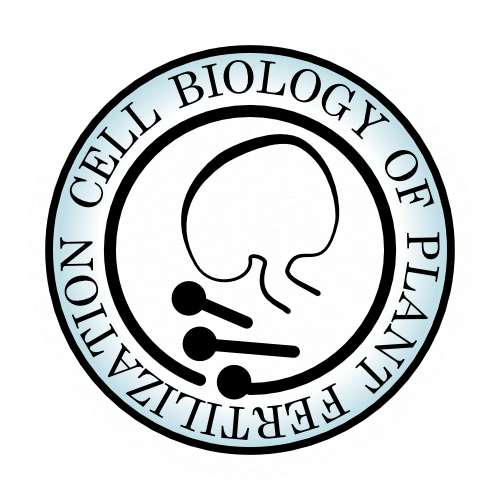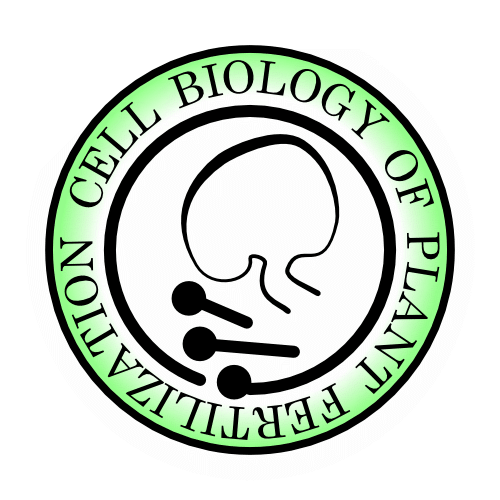
Research Project
Using Arabidopsis thaliana (Thale Cress) as a model, we are working on functional analysis of unique cell structures in male and female gametophytes.
.jpg)
Pollen tube and Sperm cell
Sperm cells are transporters of paternal genome.
Pollen tubes deliver a pair of sperm cells to the ovule.
Productions of physiologically anuclear pollen tubes

Sperm cells and vegetative nucleus are tightly connected with a tail-like structure and transported to the apical region of pollen tube.
We and Dr. Kazuki Motomura (Ritsumeikan Univ) found that ectopic deposition of cell wall callose by an overexpression of cals3m callose synthase mutant gene deprived motive force of the sperm cells.
When this cals3m transgene was introduced into a vegetative nucleus-immotile wit1 wit2 double mutant, sperm nuclei and vegetative nucleus were detected at the basal region, isolated from apical region by thick callose plugs.
Surprisingly, the physiologically anuclear pollen tubes could grow like wild-type pollen tubes, indicating hidden robust tip-growing potential of pollen tube without de novo transcription from vegetative nucleus.
The pollen tube robustness was also showen by an analysis of bnb1 bnb2 wit1 wit2 quadruple mutant.
Dr. Shohei Yamaoka (Kyoto Univ.) showed that loss of function of BNB1 and BNB2, germ line-specific transcription factors homologous to liver wort BONOBO, produced pollen without sperm cells.

The bnb1 bnb2 double mutant pollen tubes display apical transport of vegetative nucleus.
In the bnb1 bnb2 wit1 wit2 quadruple mutant pollen tubes, vegetative nuclei lost their motility but showed persistent growth capability.
We are studying molecular mechanism of sperm cell transport.
by Ikoma
Peri-germ cell membrane
The peri-germ cell membrane is a membrane structure enclosing a pair of sperm cells
The name of peri-germ cell membrane was unified after international arguments
We speculate this membrane plays pivotal roles in sperm cell transport and fertilization.
Breakdown of
Peri-Germ Cell Membrane

Pollen that discharge sperm cells in the ovule where double fertilization takes place.
After the discharge, sperm cells need to remove peri-germ cell membrane to prepare direct contact to egg cell or central cell.
We succeeded in capturing the rapid fragmentation of peri-germ cell membrane (IVPM in the report below) upon sperm cell discharge.
We are trying to identify the factors responsible for the fragmentation of peri-germ cell membrane.
Synergid cells and Filliform apparatus

Two synergid cells are gatekeepers of the ovule.
They attract pollen tubes and facilitate sperm cell release.
Polar secretion of pollen tube attractants
Synergid cells have a special glandular structure called the filamentous apparatus on the micropylar side, where the cell membrane and cell wall are complicatedly invaginated.
Pollen tube attractant peptides are released from the filiform apparatus but the mechanism of polar secretion was unknown.
We elucidated that the filamentous actin (F-actin) are required for the polar secretion mechanism.
Furthermore, it was found that the F-actin filaments temporarily disappeared upon pollen tube discharge but regenerated a few hours later in persistent synergid.
This F-actin dynamics might correspond to the persistent synergid activity: it stops attraction for a while after first pollen tube reception but resume attraction when the ovule failed double fertilization.
Further studies of dynamic changes of F-actin and peptide secretion
would elucidate new male-female communication necessary for double fertilization.
Endosperm and Cell fusion
Fertilized central cell, or primary endosperm, undergoes rounds of nuclear division.
Primary endosperm absorbs persistent synergid by an unusual cell fusion.


Cell fusion and termination of pollen tube attraction
Rapid termination of pollen tube attraction occurs in fertilized ovule by several polytubey block pathways. Inactivation of persistent synergid is one of the major polytubey block mechanisms.
During inactivation, persistent synergid is absorbed by early endosperm via cell-to-cell fusion.
The Synergid-Endosperm fusion (SE fusion) appears to be a unique cell elimination system.
We are looking for a key factor required for SE fusion.
The mutant analysis of SE fusion would answer the mystery why some flowering plants evolved this complicated cell elimination system.

Egg cell
Egg cells are essential for the birth of next generation.
How do egg cells achieve a fertilization success rate of over 90%?

Patchy extracellular structure
Electron micrographs demonstrated that the egg cell produce patch-like extracellular structure along the boundary of the central cell.
Since this area corresponding to the putative fertilization zone, the patchy structure may be involved in double fertilization.
We are studying secretory proteins required for the formation of the patchy structures and their function.

